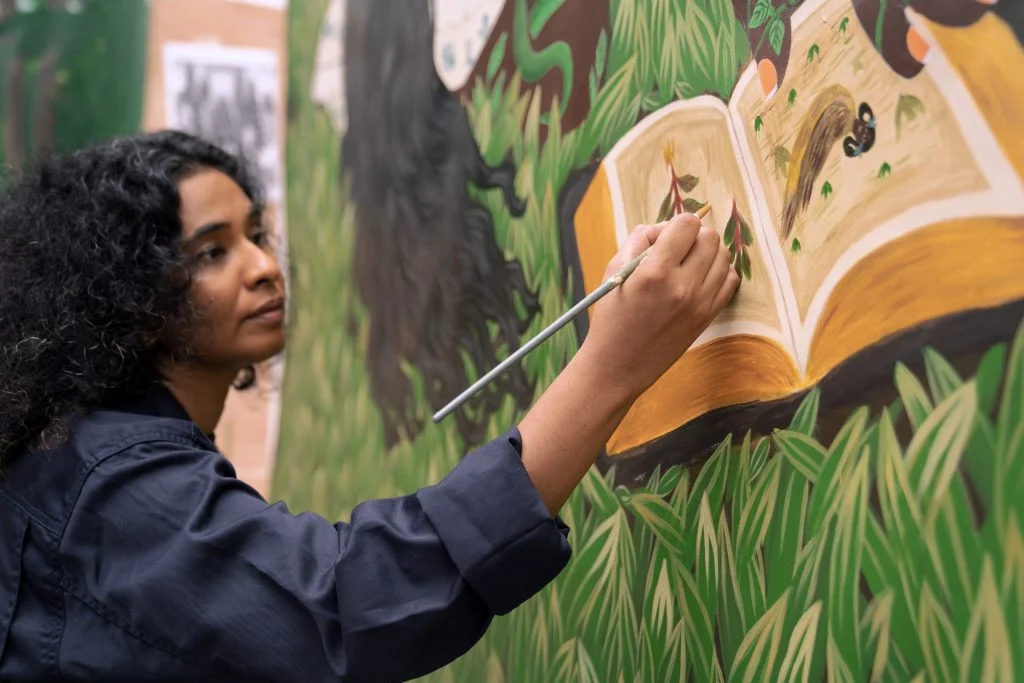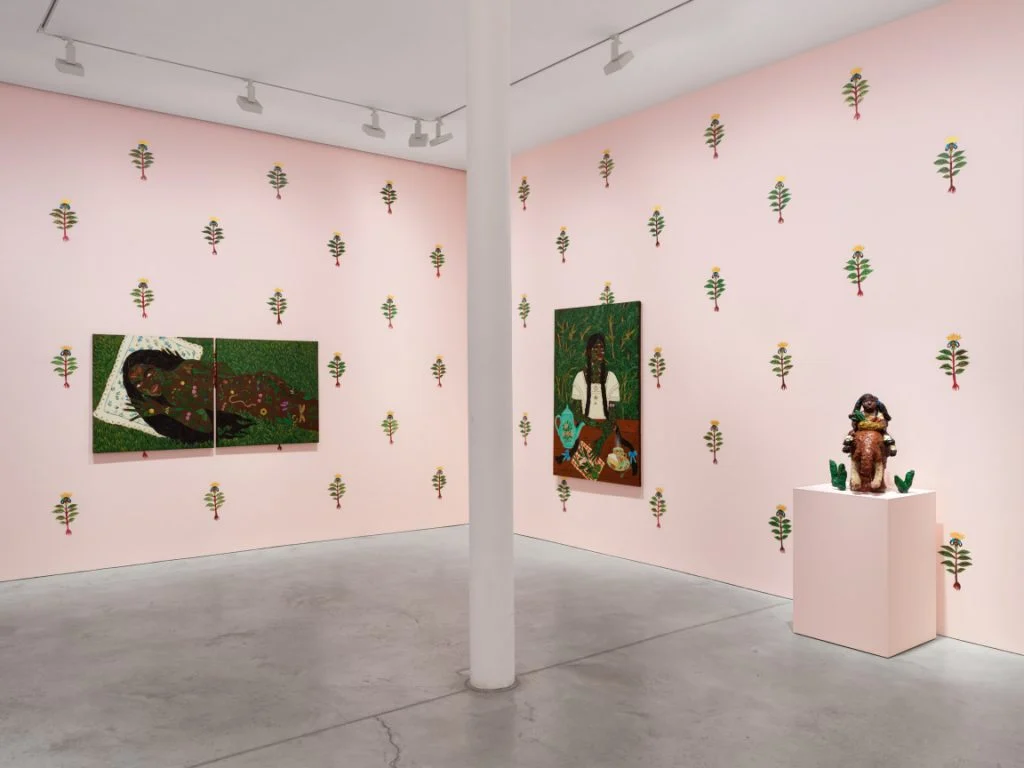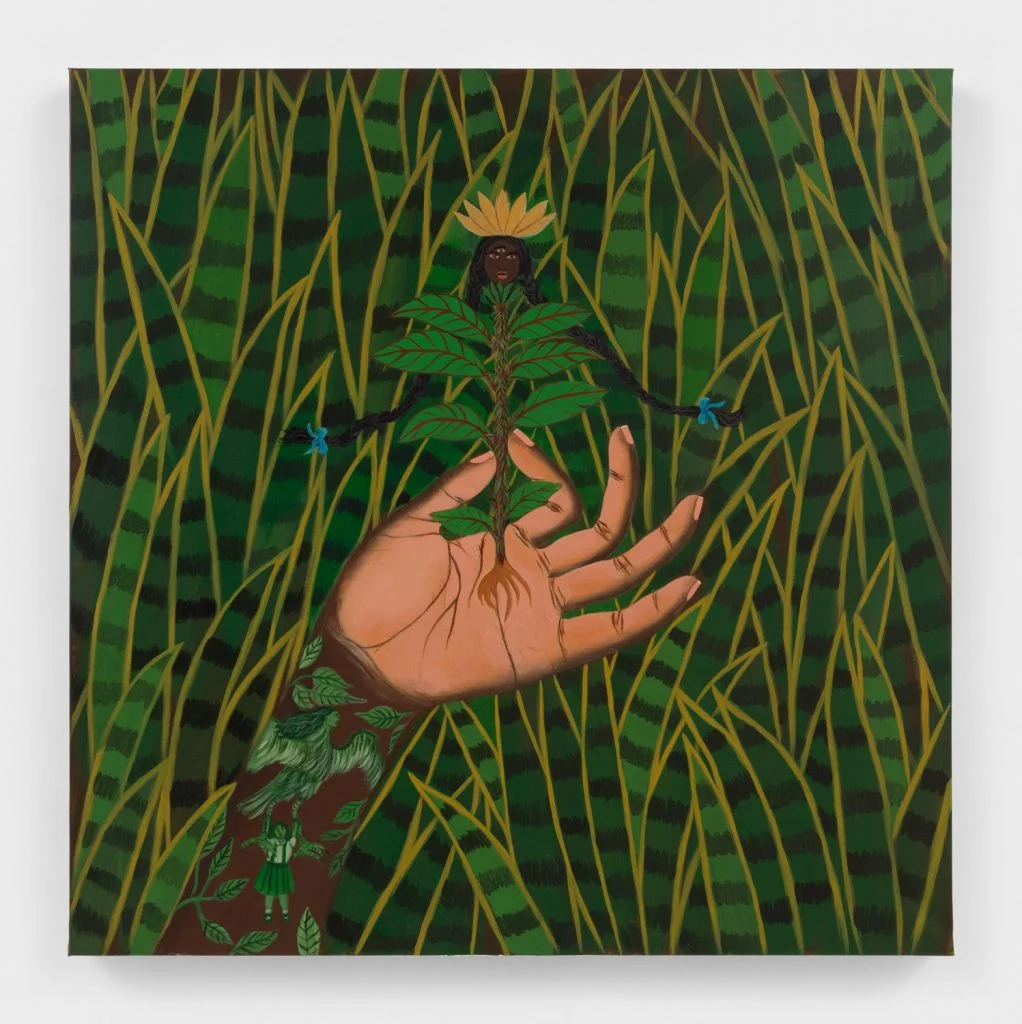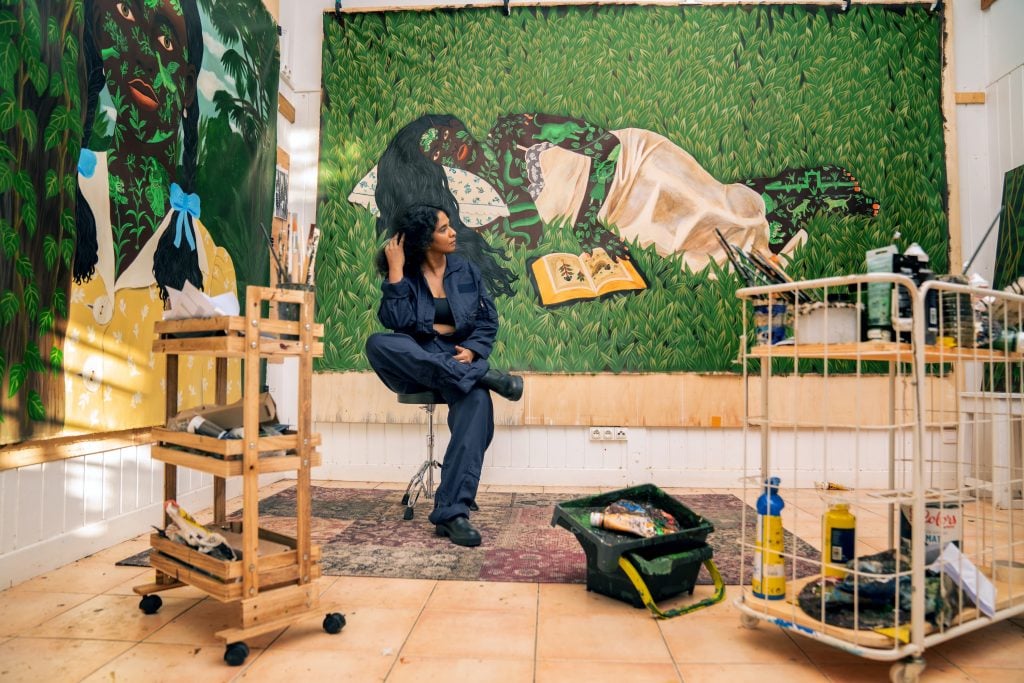
At the confluence of myth, memory, and botanical symbolism, Kelly Sinnapah Mary has emerged as a transformative voice in contemporary Caribbean art. With her striking portraits and vibrant visual storytelling, she crafts an alternate universe—both deeply personal and unmistakably political—where the line between nature and humanity is deliberately blurred. Now taking center stage in New York with her solo exhibition The Book of Violette, the Guadeloupean artist is inviting the global art world to see the Caribbean not as a peripheral curiosity, but as a dynamic center of narrative resistance and creative power.
Her protagonist, Violette, a woman adorned in lush green motifs with a mystical third eye on her forehead, encapsulates much more than a fictional character—she is an embodiment of intergenerational wisdom, ancestral connection, and ecological awareness. Through paintings and sculptures that blend the fantastical with the deeply rooted, Kelly Sinnapah Mary offers not just visuals, but visions—prophetic, surreal, and grounding.
Roots in Guadeloupe: Geography as Genesis
Born in 1981 on the French overseas territory of Guadeloupe, Sinnapah Mary’s Caribbean identity is not just a backdrop to her work—it is its foundation. Her island home is not merely an aesthetic influence; it is a narrative force. The sound of roosters crowing, the scent of tropical air, and the presence of her family form a sensory bedrock from which her stories sprout.
By choosing to remain and work in Guadeloupe rather than relocating to a European art capital, the artist maintains an authenticity and rootedness that pervades her work. “My studio is a part of my practice,” she said in a recent interview. “The land speaks through my brush.” Her refusal to detach from her geographical roots is a political act—one of self-determination and a rejection of colonial displacement.

Violette: A Living Archive of Caribbean Knowledge
Violette is more than an artistic motif; she is a symbol, a messenger, and a shapeshifter. Inspired by Sinnapah Mary’s paternal grandmother, Violette draws from a lineage of Caribbean women whose knowledge of plants, healing, and earth-centered living was passed down orally through generations.
“She had the hands of the earth,” the artist recalls of her grandmother. “She didn’t just grow plants—she communed with them.” This transference of knowledge becomes tangible in her artwork, where botanical patterns are not just decorative, but biographical, spiritual, and political.
In some artworks, Violette is depicted as part-plant, with vine-like tattoos curling around her body and leaves sprouting from her fingers. In others, she takes on mythic forms—riding tigers, multiplying into goddesses, dissolving into the soil. The theme is clear: humanity and nature are not separate, but interconnected and interdependent.
A Subversion of Colonial Tropes
In her earlier works, Sinnapah Mary introduced the figure of Sanbras—a reinterpretation of the problematic character from The Story of Little Black Sambo. Rather than perpetuating colonial caricature, she reclaims the figure, adorning her with religious symbols, braided hair that hosts birds, and a mischievous yet wise expression.
“Sanbras is my rebellion,” she explains. “She runs from the systems that try to contain her. She creates new worlds.” This character evolved into Violette, a more mature iteration that carries the weight of heritage and the vision of the future. Where Sanbras was a fugitive, Violette is a prophet.
The use of magical realism—a hallmark of Caribbean literary giants such as Maryse Condé and Aimé Césaire—becomes a tool for decolonization. It allows Sinnapah Mary to build a world where indigenous knowledge systems are not quaint traditions, but essential truths.
Cultural Literacy and the Power of Books
Books appear frequently in Sinnapah Mary’s installations—not just as props, but as portals. Her influences range from children’s fables to philosophical tomes. The presence of literary references in her work is a nod to her hybrid intellectual lineage: part academic, part ancestral, wholly Caribbean.
She cites figures like Suzanne Césaire, whose writings during the Negritude movement argued for a poetics of relation, and philosopher Édouard Glissant, who championed opacity and the right not to be understood through colonial lenses. “Their work taught me that ambiguity is power,” she says. “It protects us from being flattened by external expectations.”

Eco-Spirituality and Environmental Commentary
In works like Girl Plant and Invisible Vegetation of Desire, Sinnapah Mary doesn’t merely depict ecological scenes—she weaves environmental justice into the very fabric of her narratives. One ongoing concern in her practice is the ecological fallout from chlordecone, a pesticide used extensively in the French Caribbean well after its ban in mainland France. This toxic legacy, which has led to widespread health issues, finds symbolic representation in the hybrid forms her characters take.
By portraying human figures as partly vegetal, Sinnapah Mary collapses the distinction between species. This is not a visual trick—it’s an ethical assertion. “To poison the land is to poison the people,” she has said. “We are not separate from the soil.”
Her approach draws parallels with the eco-feminist philosophies of Vandana Shiva and the indigenous spiritualities of the Caribbean, which recognize plants and trees as sentient, communicative beings. This belief system is evident in every green tendril that winds its way across her canvases.
Techniques, Textiles, and Transcendence
From a technical standpoint, Sinnapah Mary’s work is layered both figuratively and literally. She employs intricate textile motifs, reminiscent of Indian block printing and African wax prints. Her recent interest in Indian and Persian miniatures has expanded her visual language, resulting in compositions rich in symmetry, detail, and color harmony.
“I discovered my Tamil Nadu roots late in life,” she shares. “It was a moment of awakening. Suddenly, patterns I had been drawn to intuitively made historical sense.” This rediscovery of heritage adds a transcultural texture to her work—further complicating and enriching its identity.
Her compositions also reflect the dreamlike stillness of Henri Rousseau and the tropical sensuality of Paul Gauguin, though she subverts their colonial gaze by placing a Caribbean woman at the center of the narrative—not as muse, but as creator.

From Regional Voice to Global Vision
Sinnapah Mary’s international ascent has been swift. Her debut solo exhibition in the United States took place at Aicon Gallery in 2024. That same year, her work was featured in the landmark exhibition Surrealism and Us, highlighting diasporic artists. And her inclusion in everything slackens in a wreck at the Ford Foundation Gallery marked her as a key voice in the global south’s contribution to postcolonial art.
Her work is increasingly being acquired by institutions and private collectors seeking not just beauty, but vision—art that says something vital about our times. Yet, for all the accolades, she remains deeply connected to her roots.
“I’ve changed in many ways,” she admits. “I practice Aikido now. I’ve been vegetarian for three years. These aren’t trends—they’re part of how I align my inner life with my work.”
Conclusion: Painting a Future Rooted in the Past
Kelly Sinnapah Mary is not merely creating art; she is cultivating a worldview. Through her visionary characters, folkloric symbols, and commitment to ancestral wisdom, she presents the Caribbean not as a colonial footnote but as a sovereign source of philosophical, environmental, and spiritual depth.
In her world, transformation is not just possible—it’s necessary. The future, she insists, belongs to those who remember where they came from while imagining what else they could become.

